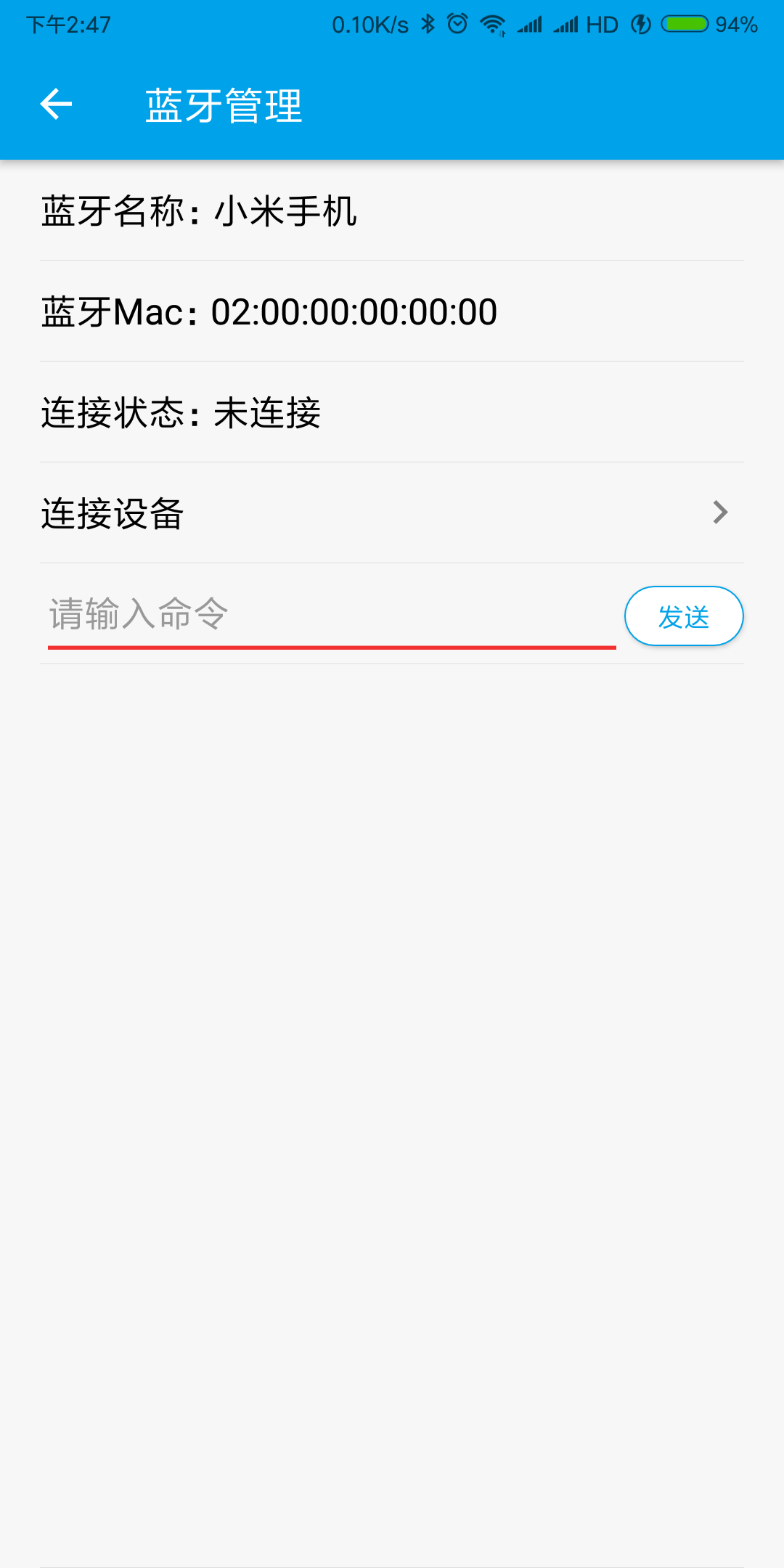持续更新中,本项目基于QuickComponent开发
本项目包含完整的代码Demo,可直接clone
zxing 扫描、生成、解析二维码、近距离扫码
该基类确定了业务逻辑处理的规范,如果再使用dagger2+MVP模式,将大大提高代码的可读性。
使用基类布局将获得标题,而且该标题可以根据自己需求onResultToolbar替换为自已的,可单独设置返回按钮图片,点击事件。
加入了泛型的快速获取Viewr的getView(),快速获取intentk中的数据getTransmitValue()。还有showToast(),showSnackbar()等小工具
快速设置onClickListener,可成组设置,也可单独设置
setOnClickListener(object :OnClickListener2(){
override fun onClick2(view: View?) {
}
},id1,id2,id3,id4,id5)快速设置menu,无需再像传统那样分开创建、监听。如果不使用menu,也可设置rightView。
setMenu(R.menu.navigation) { menu ->
when(menu?.itemId){
}
true
}示例
class TestActivity : BaseActivity() {
override val isUsingBaseLayout: Boolean
get() = super.isUsingBaseLayout/*是否引用基类布局,如不引用将没有标题,开发者自行实现*/
override val isShowTitle: Boolean
get() = super.isShowTitle/*是否显示标题*/
override fun onResultLayoutResId(): Int {/*返回layout*/
TODO("not implemented") //To change body of created functions use File | Settings | File Templates.
}
override fun onInit() {/*初始化变量*/
TODO("not implemented") //To change body of created functions use File | Settings | File Templates.
}
override fun onInitLayout() {/*初始化Layout相关*/
TODO("not implemented") //To change body of created functions use File | Settings | File Templates.
}
override fun onBindListener() {/*绑定监听事件*/
TODO("not implemented") //To change body of created functions use File | Settings | File Templates.
}
override fun start() {/*初始化完毕,开始加载数据*/
TODO("not implemented") //To change body of created functions use File | Settings | File Templates.
}
}同上,不同的是默认不显示标题
这此基类使用RecyclerView,快速构建基本的列表,让开发者只需要专注业务逻辑的处理
基本列表只需重写必要的回调即可,如果有特殊需求也可自行重写其他方法,像分割线,刷新方法,加载方法,错误提示等,非常灵活
基本实用示例
class TestListActivity : BaseListActivity() {
/**
* 流程:先初始化基类本身需要的属性,比如isPullRefreshEnable、isLoadMoreEnable、onResultAdapter、onResultLayoutManager之后,再走到onInit()
* 此处应当初始化业务逻辑的变量,
*/
override fun onInit() {
getAdapter<Adapter>().setOnItemClickListener { v, position ->
showToast(String.format("点击了第%d项", position))
}
getAdapter<Adapter>().setOnClickListener(BaseRecyclerViewAdapter.OnClickListener{ view, holderRv, position ->
},R.id.你的ID1,R.id.你的ID2)
}
override fun start() {
onRefresh()
}
/*是否开启下拉刷新*/
override fun isPullRefreshEnable(): Boolean = true
/*是否开启上拉加载*/
override fun isLoadMoreEnable(): Boolean = true
/*返回适配器*/
override fun onResultAdapter(): RecyclerView.Adapter<*> = Adapter()
/*布局管理器,默认为纵向管理器上下滚动*/
override fun onResultLayoutManager(): RecyclerView.LayoutManager {
return super.onResultLayoutManager()
}
override fun onResultUrl(): String = "http://www.baidu.com"
override fun onResultParams(params: MutableMap<String, String>) {
params["userName"] = "张三"
}
override fun onRequestDataSuccess(jsonData: String?, isPullRefresh: Boolean) {
if (isPullRefresh) {//下拉刷新
} else {//上拉加载
}
}
inner class Adapter : BaseRecyclerViewAdapter<String>() {
override fun onResultLayoutResId(): Int {
TODO("not implemented") //To change body of created functions use File | Settings | File Templates.
}
override fun onBindData(holderRv: BaseViewHolder, position: Int, itemData: String?) {
TODO("not implemented") //To change body of created functions use File | Settings | File Templates.
}
}
}带Header的基类列表,描述:给数据分类,不同ID分为多组,例如:6月、7月的数据各分为两组,并且header浮在顶部
列表使用XStickyListHeadersListView,由于此列表Adapter复杂,遂封装进基类,开发都只需要处理业务逻辑即可。
基本使用示例:
class TestListActivity2 : BaseListActivity2<String>() {
override fun onInit() {
TODO("not implemented") //To change body of created functions use File | Settings | File Templates.
}
override fun start() {
TODO("not implemented") //To change body of created functions use File | Settings | File Templates.
}
override fun isPullRefreshEnable(): Boolean {
TODO("not implemented") //To change body of created functions use File | Settings | File Templates.
}
override fun isLoadMoreEnable(): Boolean {
TODO("not implemented") //To change body of created functions use File | Settings | File Templates.
}
override fun onResultUrl(): String {
TODO("not implemented") //To change body of created functions use File | Settings | File Templates.
}
override fun onResultParams(params: MutableMap<String, String>?) {
TODO("not implemented") //To change body of created functions use File | Settings | File Templates.
}
override fun onRequestDataSuccess(jsonData: String?, isPullRefresh: Boolean) {
TODO("not implemented") //To change body of created functions use File | Settings | File Templates.
}
override fun onResultItemLayout(): Int {/*返回列表LayoutId*/
TODO("not implemented") //To change body of created functions use File | Settings | File Templates.
}
override fun onResultHeaderLayout(): Int {/*返回头部LayoutId*/
TODO("not implemented") //To change body of created functions use File | Settings | File Templates.
}
override fun onBindHeaderId(itemData: String?, position: Int): Long {/*返回用于分类的ID,例如:根据月份分类,应当返回月月份,*/
TODO("not implemented") //To change body of created functions use File | Settings | File Templates.
}
/*绑定item数据*/
override fun onBindDataItemView(holderRv: BaseRecyclerViewAdapter.BaseViewHolder?, itemData: String?, position: Int) {
TODO("not implemented") //To change body of created functions use File | Settings | File Templates.
}
/*绑定header数据*/
override fun onBindDataHeaderView(holderRv: BaseRecyclerViewAdapter.BaseViewHolder?, itemData: String?, position: Int) {
TODO("not implemented") //To change body of created functions use File | Settings | File Templates.
}
}考虑到不同使用场景,提供了fragment版本,使用方法同上
同上
目前此类存在内存泄露的问题,暂未解决
recyclerView基类,集成了点击事件、长按、item内的view点击
最简单的使用方法
class Adapter : BaseRecyclerViewAdapter<Int>() {
override fun onResultLayoutResId(): Int = R.layout.item_commodity_list<br>
override fun onBindData(holderRv: BaseViewHolder, position: Int, itemData: Int?) {
// holderRv.setImg(R.id.coverIv, itemData!!)
holderRv.getImageView(R.id.coverIv).setImageResource(itemData!!)
}设置margin与padding。
inner class Adapter : BaseRecyclerViewAdapter<String>() {
override fun onResultLayoutResId(): Int = R.layout.item_discover_list
override fun onBindData(holderRv: BaseViewHolder, position: Int, itemData: String?) {
holderRv.setImg(R.id.contentIv, itemData)
}
//----------margin 一般用于CardView
override fun onResultItemMargin(): Int = 40
override fun onResultItemMarginLeft(position: Int): Int = when {
position % 2 == 0 -> 40
else -> 20
}
override fun onResultItemMarginRight(position: Int): Int = when {
position % 2 != 0 -> 40
else -> 20
}
override fun onResultItemMarginTop(position: Int): Int {
return super.onResultItemMarginTop(position)
}
override fun onResultItemMarginBottom(position: Int): Int {
return super.onResultItemMarginBottom(position)
}
//------------Padding,一般用于常规列表
override fun onResultItemPadding(): Int {
return super.onResultItemPadding()
}
override fun onResultItemPaddingLeft(position: Int): Int {
return super.onResultItemPaddingLeft(position)
}
}以回调的方式管理onActivityForResult的返回值。无需再向传统那样,先startActivityForResult,然后再监听onActivityForResult,真正做到在哪开始,就在哪结束,方便开发者debug,并且无需再为担心requestCode怎么传,会不会有重复的,有没有超出65536上限而担心,因为已经生成了唯一的requestCode,每个Activity对应一个requestCode。
开始调用
var intent=Intent(this,YourActivity::class.java)
intent.putExtra("TYPE","this is a type")
QuickStartActivity.startActivity(activity, intent, { resultCode, data ->
})在这里绑定
override fun onActivityResult(requestCode: Int, resultCode: Int, data: Intent?) {
QuickStartActivity.onActivityResult(requestCode, resultCode, data)
super.onActivityResult(requestCode, resultCode, data)
}一般来讲,A跳转到B,A中只会有一处跳转到B。如果有特殊需求,A存在多处跳转到B,就像按钮1跳转B,按钮2也要跳转到B,因为每个Activity只对应一个requestCode,所以应该以动态传值的方法来写
fun startActionB(intent:Intent){
QuickStartActivity.startActivity(activity, intent, { resultCode, data ->
})
}可在任意线程弹出,方便的使用Toast,无需在使用的时候频繁传递context,一次初始化,终生受益。
传统使用方式
Toast.makeText(activity,"这是一个Toast",Toast.LENGTH_SHORT).show()如果需要自定义时
val toast = Toast.makeText(activity, "这是一个Toast", Toast.LENGTH_SHORT)
toast.setGravity(Gravity.CENTER,0,0)
toast.show()这种方式使用时每次都需要依赖context,如果需要在子线程使用,将会变得很不方便,那么此组件如何呢
所以请看
QuickToast.showToastDefault("这是一个Toast")或者,使用链式配置参数,或者自定义Toast
QuickToast.Builder().setGravity(Gravity.CENTER).setDuration(Toast.LENGTH_SHORT).setLayoutView(customView).build().showToast("这是一个Toast")看到这里或许就有疑问了,在哪里初始化context呢,使用quickLibrary将无需处理,若只需使用此组件,重写QuickToast中的context方法即可。
示例
class CustomToast:QuickToast() {
override val context: Context
get() = super.context/*这里替换为自定义context*/
}如此就能愉快的玩耍了。
方便的使用动态广播,告别繁琐的注册与注销广播。
1、注册
QuickBroadcast.addBroadcastListener(绑定者, { action, intent ->
when (action) {
"test" -> showToast(intent.getStringExtra("test"))
"test2" -> showToast(intent.getStringExtra("test"))
}
}, "test", "test2")/*天呐,这里居然可以指定多个接受者*/2、发送广播
QuickBroadcast.sendBroadcast(Intent(), "test")如此简单的两步就完成了广播的注册与发送,so easy!
如果更复杂的使用呢,当前页面发送给多个页面。
正常写法
sendBroadcast(Intent("test"))
sendBroadcast(Intent("MyCenterFragment"))新写法
QuickBroadcast.sendBroadcast(Intent(), "test","MyCenterFragment")对于发送只需增加接收者即可,这样注册了test与MyCenterFragment的接收者都将收到你的消息。
并且此组件同一时刻不会同时触发接收者为同一监听的广播
QuickBroadcast.addBroadcastListener(绑定者, { action, intent ->
when (action) {
"test" -> showToast(intent.getStringExtra("test"))
"test2" -> showToast(intent.getStringExtra("test"))
}
}, "test", "test2")/*天呐,这里居然可以指定多个接受者*/比如,test,test2为同一组接收者。
如果发送同时发送test,test2
QuickBroadcast.sendBroadcast(Intent(), "test","test2")那只会触发早先的test,test2将不再触发。
此组件需要注意的是注册时需要传递唯一的绑定者。

